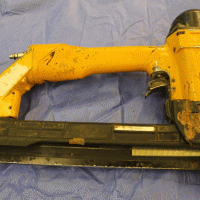Can you imagine framing a house with the tools of our forefathers, using hand saws and hammers, rather than power saws and pneumatic nail guns? Power tools have made the job much easier and faster, that even the amateur is well equipped for this kind of work.
While any tool comes with its own risks for the operator, power tools generally have the potential for greater injury. The focus of this blog is the pneumatic nailer/stapler, specifically on the equipment itself rather than on its improper use. It has been reported that approximately 37,000 emergency room visits each year are due to injuries involving nail guns.
Properly functioning and properly operated nail/stapler guns are generally pretty safe. Many are unaware, however, that the safety features of this equipment may be different based on its intended use. For professionals, efficiency is a prime concern. You may have observed how quickly fasteners can be installed in subflooring, sheathing and roofing by the professional using the “bump fire” technique possible with some nail guns. This increased efficiency does come with increased risks, particularly for a user who may not be well trained.
Actuation of a nailer/stapler requires two independent occurrences: the depression of the safety “nosepiece” of the gun against the work and the pulling of the trigger. The actuation can vary depending upon the order in which the controls are activated and whether the trigger can be held in the squeezed position to discharge multiple nails OR must be released and then squeezed again for each individual nail. Four kinds of triggers are available by combining the variations. Some nail guns are equipped with a switch that allows two or more types of triggering in the same gun.

The safest trigger for a nail gun is a “full sequential trigger”, that requires that the nosepiece first be pushed into the work, then the trigger squeezed to fire the nail; the trigger and nosepiece must both be released to fire a second nail by employing the same sequence. Bump firing is not possible with this trigger.
The “contact trigger” requires only that the nosepiece and trigger are both actuated, but sequence is not a factor- you can depress the safety nosepiece against the work and then squeeze the trigger, or you can squeeze the trigger and then depress the nosepiece. If the trigger is kept squeezed, a nail will fire each time the safety nosepiece is pushed in; in other words, bump firing is possible.
The “single sequential trigger” requires a certain order of actuation, like the full sequential trigger. The safety nosepiece must first be depressed, then the trigger is squeezed to fire a nail; the safety nosepiece can then be slid along the work (while depressed) and a second nail can be fired by releasing and re-squeezing the trigger. Bump firing is not possible.
The “single actuation trigger” does not depend on actuating the nosepiece and trigger in any particular sequence. It differs from the single sequential trigger only in that the initial order of depressing the nosepiece does not matter. Bump firing of the first nail is possible.
To maximize safety, only the nailer with a full sequential trigger should be used by the less experienced and less trained operator. Nail guns should be regularly tested for proper performance. The Warren Group has investigated cases involving nail gun malfunctions wherein the nail will fire when only the trigger is squeezed, regardless of the position of the safety nosepiece. A nail gun that will fire a nail through space rather than directly into the wood being fastened is obviously an extreme hazard. Should you need assistance in evaluating a nail gun/stapler involved in an injury, we have the experience and expertise at Warren to help you.
Founded in 1997, The Warren Group, forensic engineers and consultants provides technical investigations and analysis of personal injury and property claims as well as expert testimony for insurance adjusters and attorneys. Extremely well versed in the disciplines of mechanical, electrical, chemical, structural, accident reconstruction and fire and explosion investigation, our engineers and consultants are known for delivering the truth — origin, cause, responsibility and cost of an event or claim — with unmistakable clarity.



